The buckskin horse, a creature of remarkable beauty and resilience, has long captured the hearts of equestrians and horse enthusiasts worldwide. Known for their distinctive coat color and versatile abilities, these horses are not a breed but a color phenomenon that spans across various breeds. In this comprehensive guide, we delve into the buckskin horse characteristics, genetics, types, and more, offering a window into the world of these magnificent animals.
Unveiling the Ancestry of Buckskin Equines

The buckskin equine’s lineage is a chronicle of endurance, tracing back to the era of Spanish exploration. These horses, with their signature tan shades, serve as living testaments to a heritage that intertwines with both European and American histories. The origins of their lineage are connected to the majestic steeds brought over by the Spanish Conquistadors, reflecting an evolutionary journey entwined with human history.
Charting the Evolution of Buckskin Equines
In the annals of equine history, the arrival of Iberian horses with the Spanish explorers marked a pivotal moment. These animals, renowned for their robustness and agility, found a new destiny in the Americas. The fusion of these horses with indigenous breeds led to the emergence of the hardy buckskin, which became a cornerstone in the lives of indigenous peoples, settlers, and pioneers, thus playing a pivotal role in the narrative of the American frontier.
- The introduction of Iberian horses by Spanish settlers marks a significant chapter in equine history.
- The emergence of the buckskin through crossbreeding with local horse populations.
- The role of buckskins in the cultural and practical lives of various American societies.
Understanding the Genetic Distinctions of Buckskin Equines
The enchanting golden coat of buckskins, devoid of the distinctive markings seen on duns, arises from precise genetic mechanisms. The cream dilution gene imparts the buckskin’s iconic color, distinguishing it from the effects of the dun gene, which is responsible for the characteristic dorsal stripe and leg barring. This distinction is key for aficionados and breeders in identifying and appreciating the nuances among these equines.
| Buckskin Equines | Dun Equines |
|---|---|
| Lack the ‘primitive’ markings | Exhibit ‘primitive’ markings |
| Coloration from the cream gene | Coloration from the dun gene |
Understanding the genetic and historical aspects enriches the narrative of the buckskin equine, underscoring its role as a symbol of tenacity and the adventurous legacy it represents. The deeper insight into the buckskin horse history and the distinctions between buckskin and dun horses further bolsters the appreciation for these equine marvels.
Delving Deeper into Buckskin Horse Traits
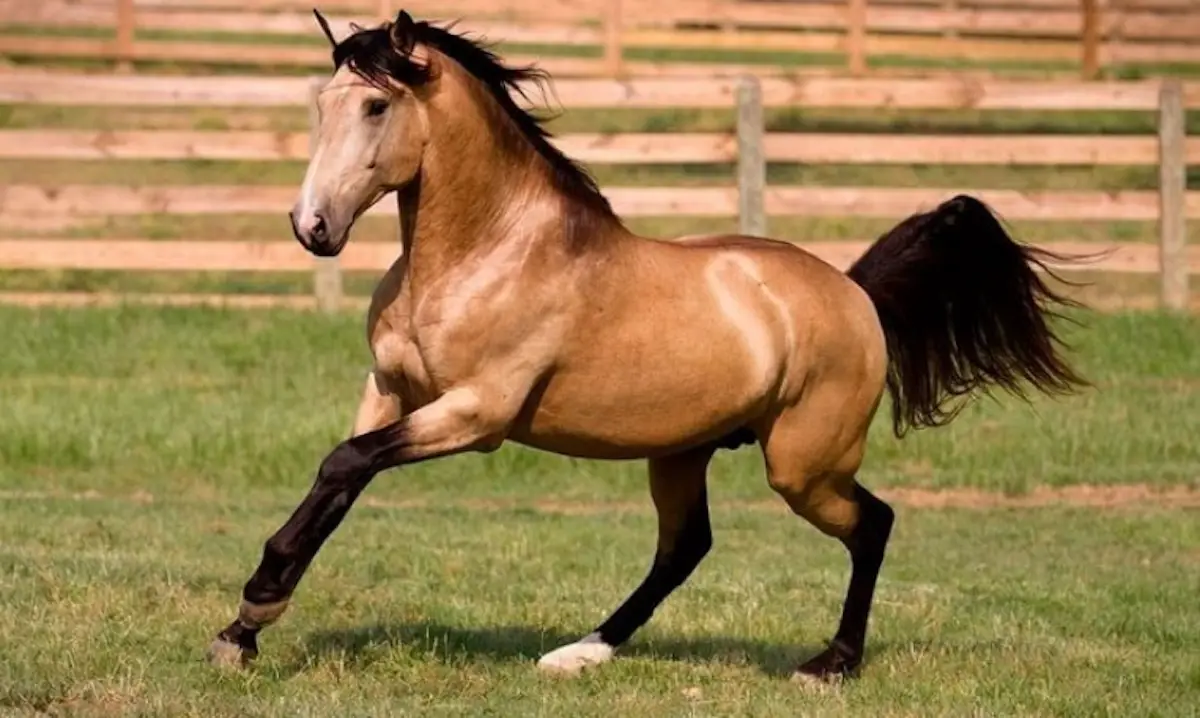
The buckskin horse, renowned for its stunning coat and pleasant demeanor, stands out in the equine world. Their characteristics, which extend beyond their visual appeal, make them a favored choice in a multitude of equestrian activities. We explore the subtleties of their colors and the general personality traits that make them so adored.
Examining the Spectrum of Buckskin Shades
Buckskin horses showcase a captivating range of colors, each a result of a unique genetic influence. The array of hues includes:
- Pale Cream: A soft, almost white tone that can change under different lights.
- Lustrous Gold: The deep, shimmering shade that is synonymous with the classic buckskin look.
- Dark Buckskin: A richer, more intense variation, offering an imposing presence.
These shades are a testament to the cream gene’s impact, modulated by factors such as environmental conditions, nutrition, and care, all of which enrich the diversity of the buckskin’s coloring.
Assessing the Nature of Buckskin Horses
Buckskin horses are often valued for their composed and friendly temperaments. Ideal for riders at all levels, they exhibit traits such as:
- Forbearance: Their calm nature makes them reliable partners for learners.
- Cleverness: They are noted for their ability to grasp new skills swiftly.
- Flexibility: Their versatility shines through, whether on a leisurely trail or in the competitive arena.
Despite these commonalities, it’s crucial to remember that individual buckskins may show varying personality features based on factors like their breed and upbringing.
Considering Physical Qualities Beyond the Buckskin Palette
Buckskins are not only prized for their coat but also for their physical capabilities. Attributes often associated with these horses include:
- Robustness: Many exhibit a muscular build that suits a variety of equestrian endeavors.
- Resilience: Their stamina is a boon for activities that require endurance.
- Agility: Their prowess in Western riding events is often a result of their athletic nature.
Yet, these qualities can differ from one buckskin to another, influenced by their specific breed heritage.
The Role of Care in Buckskin Horse Development
Proper care plays a pivotal role in developing both the color and character of buckskin horses. Environmental factors, such as sunlight, can affect the depth of their coat color, while good grooming practices enhance its luster. Similarly, consistent and positive handling can foster the serene temperament that buckskins are esteemed for. Attention to diet, exercise, and a nurturing setting are all essential for these horses to thrive and exhibit their best traits.
By understanding the distinctive characteristics, varied colors, and innate temperament of buckskin horses, and integrating this knowledge into their care, equestrians can bring out the inherent splendor and kind-hearted essence of these horses. Celebrating each buckskin’s uniqueness allows them to reach their highest potential in both aesthetics and performance.
Exploring the Genetic Complexities of Buckskin Equines
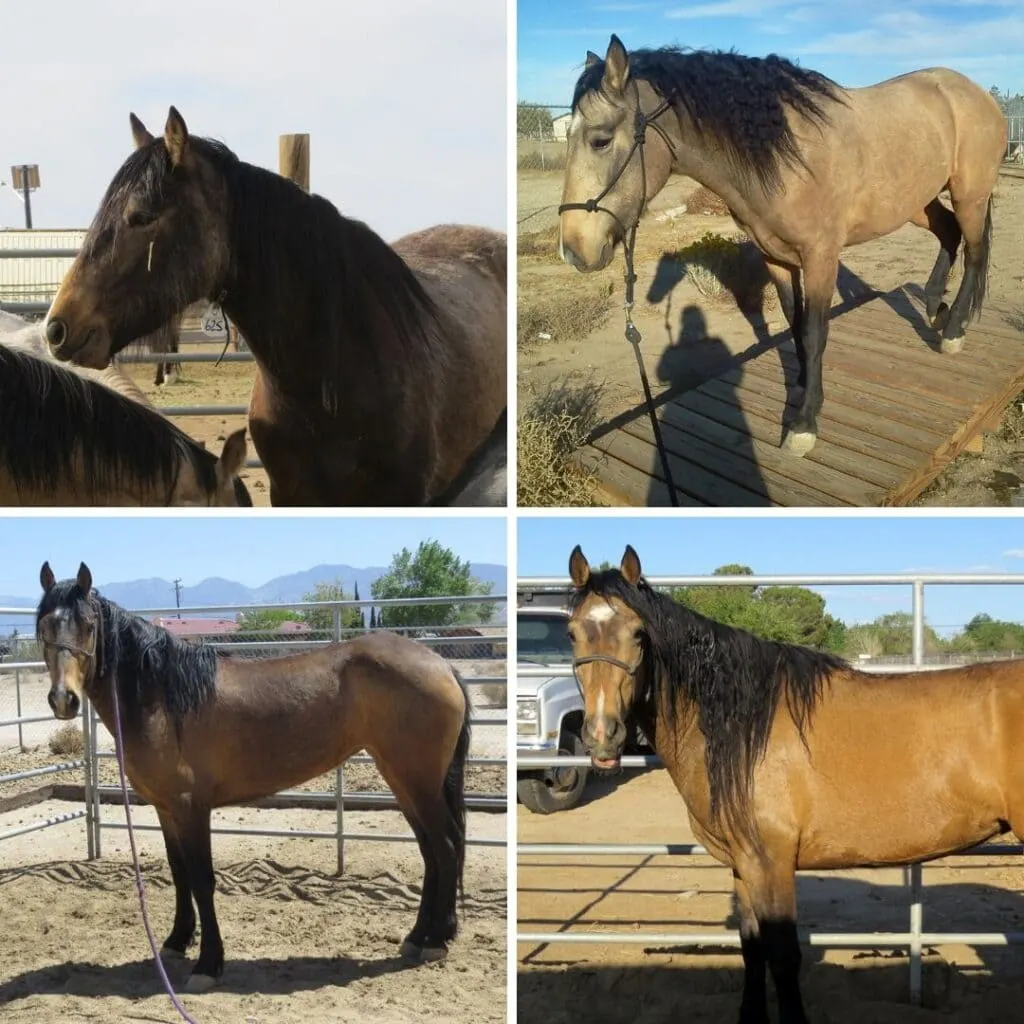
The genetic foundation of the buckskin equines is a testament to their enchanting coat color. The cream gene, a dilution allele, is responsible for the unique shades of buckskin horses, modifying the base coat while retaining the darker mane and tail. This genetic element is the focus of interest for those studying equine genetics and those involved in selective breeding.
Delving into the Cream Gene’s Impact
On the molecular level, the cream gene selectively dilutes red pigment without altering black pigment, resulting in the buckskin’s distinct coat ranging from golden to creamy-white tones. The gene’s expression can lead to heterozygous or homozygous manifestations, each influencing the coat color in different ways, such as producing palominos or cremellos when homozygous.
Patterns of Genetic Inheritance
The inheritance of the cream gene is characterized by an autosomal incomplete dominant pattern. A single copy can cause the dilution effect, while two copies intensify it. Breeders prioritize understanding these patterns to produce the desired buckskin offspring, often employing genetic testing as a tool in their breeding programs.
Diversity in Genetic Expression
While the cream gene is pivotal, other genetic elements and environmental factors also influence the buckskin color spectrum. The horse’s base coat color, additional modifier genes, and even sun exposure and diet can impact the coat’s appearance, contributing to the individuality of each buckskin horse.
Technological Advances in Genetic Testing
Modern genetic technology offers methods for identifying the presence of the cream gene, aiding in the prediction of coat colors. DNA testing and the analysis of genetic markers associated with the cream gene are integral in mapping its effects on equine coloration.
The Cream Gene’s Influence on Equine Colors
The cream gene’s interaction with different base coat colors leads to a variety of equine coat colors beyond buckskin, such as the creation of palominos from chestnut base coats. The gene’s influence extends across the equine color spectrum, contributing to the diversity of horse coat colors.
The intricate study of the cream gene enhances our understanding of buckskin equines’ dazzling coat colors and the genetic intricacies behind them, allowing for a greater appreciation of their genetic heritage and visual splendor.
Delving into the Buckskin Horse Varieties
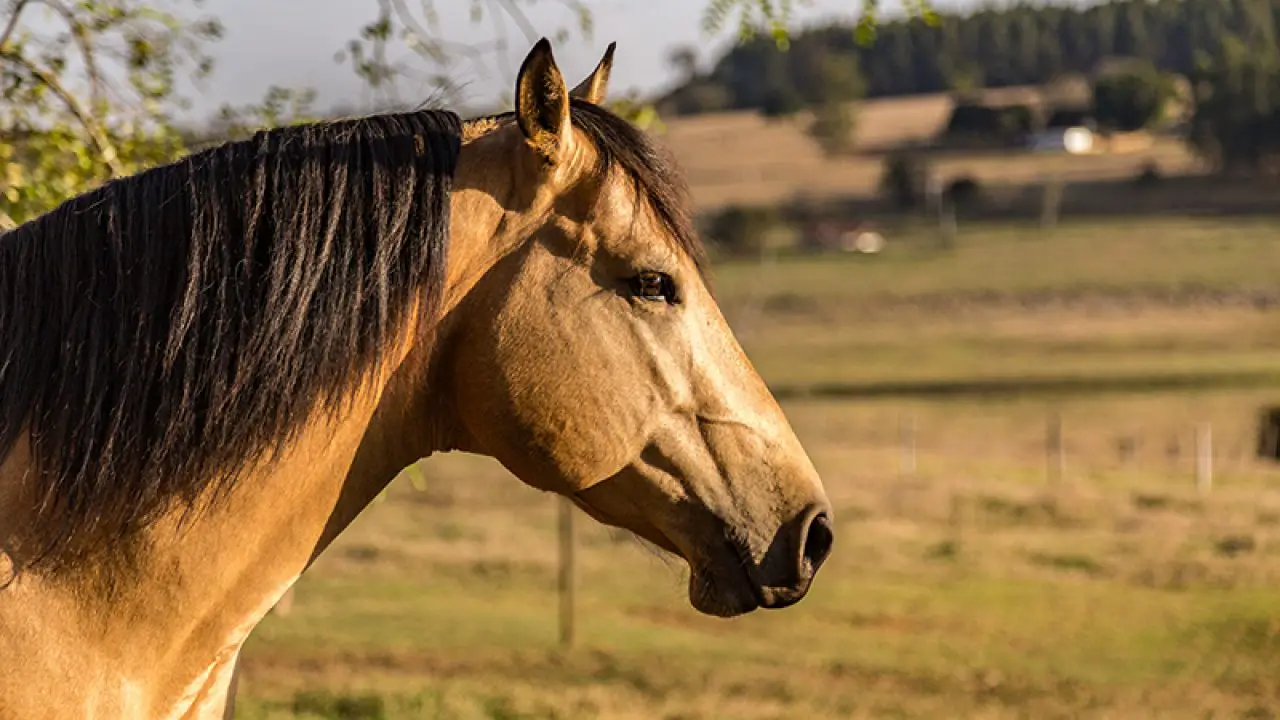
The buckskin horse, with its sun-kissed hues, presents a spectrum of captivating variations. While all buckskin horses share a connection through the cream gene’s influence on their coat color, each type exhibits unique traits and patterns. Let’s explore the individual qualities of these horses and appreciate the diversity they bring to the equine color palette.
Exquisite Buttermilk Buckskin Horses
The buttermilk buckskin horse’s coat offers a lighter expression of the buckskin color, exuding an understated beauty. Its pale, creamy shade, which can seem to shift with varying light, demonstrates the range of the cream gene’s dilution effect on the base color.
Captivating Classic Buckskin Horses
A golden coat with contrasting black points is characteristic of the classic buckskin horse, embodying the iconic buckskin image. This type’s golden color is enriched by a striking contrast, showcasing the depth of the buckskin’s coat variations.
Smokey Elegance of Sooty Buckskin Horses
Sooty buckskin horses bear a smoky pattern over their base coat, offering a darker and more complex visual texture. This genetic influence, combined with the cream gene, results in a range of shading from subtle to richly layered, adding a mysterious allure to these horses.
Gleaming Silver Buckskin Horses
The rare silver buckskin horse captivates onlookers with its metallic-like sheen. This extraordinary luster arises from a combination of the cream gene with possibly rare base colors or modifiers, creating a shimmering effect that distinguishes them from other buckskins.
Dappled Grace of Buckskin Horses
Dapple buckskin horses showcase light circular patterns across their coat. These dapples not only enhance the horse’s aesthetic appeal but also reflect a healthy and well-conditioned coat, adding depth and a marbled elegance to their appearance.
- Buttermilk Buckskin: Exhibits a delicate, creamy coat with a chameleonic effect in different lights.
- Classic Buckskin: Features a deep golden hue with striking black mane, tail, and lower legs.
- Sooty Buckskin: Presents a smoky overlay on the coat, providing a rich, textured look.
- Silver Buckskin: Displays a rare, silvery gloss that makes these horses exceptionally radiant.
- Dapple Buckskin: Dapples signify a robust coat, adding a patterned beauty to the buckskin color.
These diverse types of buckskin horses, each with their distinctive appeal, contribute to the rich tapestry of the buckskin spectrum. Their genetic makeup and resulting coloration continue to intrigue and inspire horse enthusiasts and breeders, ensuring that the buckskin horse remains an enduring and beloved presence in the equine world.
Appreciating the Wide Array of Buckskin Horses in Different Breeds
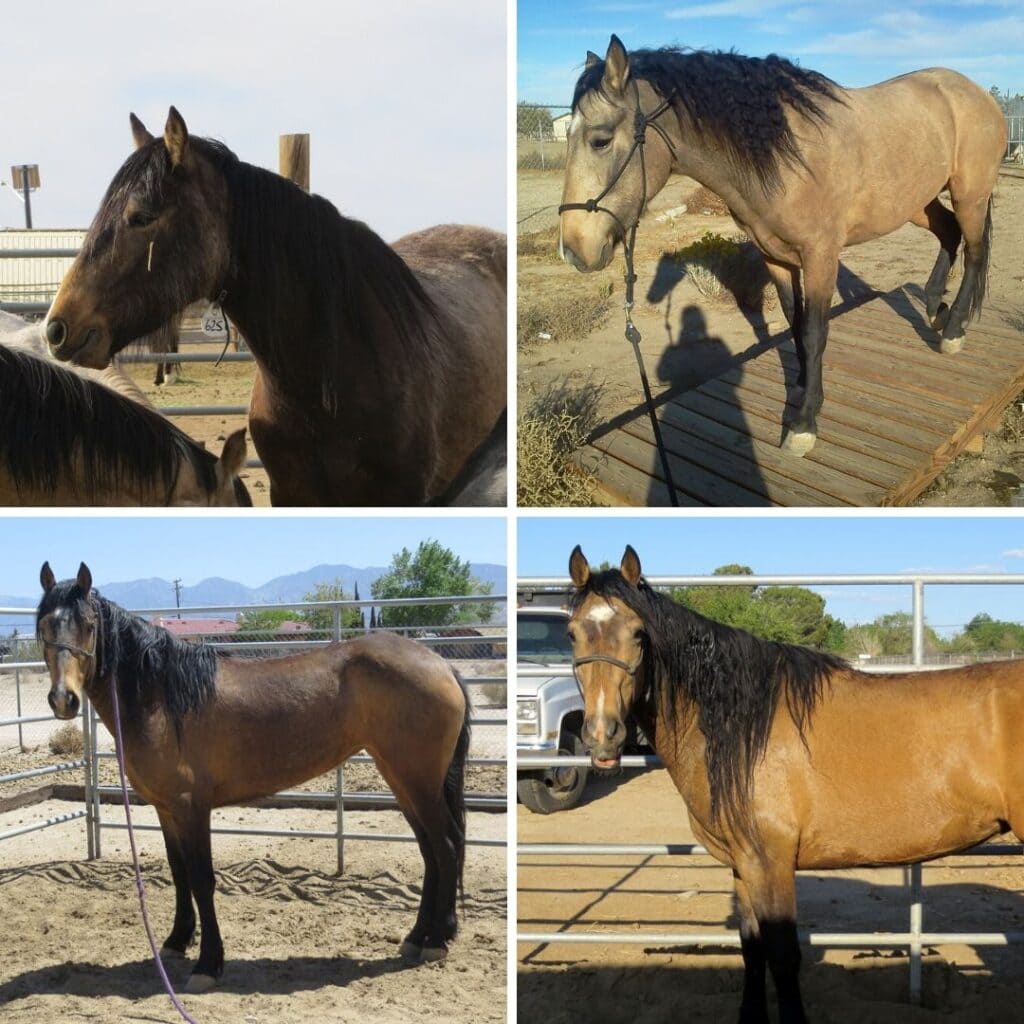
Buckskin horses, with their iconic golden coats, are not confined to a single breed but span a diverse range of equine lineages. The cream dilution gene’s interaction with a bay base coat is responsible for the buckskin color, which can be found in numerous horse breeds, each possessing its own unique traits alongside this striking hue.
American Quarter Horse Versatility in Buckskin
American Quarter Horses, esteemed for their quick acceleration and adaptability, frequently display the buckskin color. Their prowess extends from competitive rodeo events to dependable ranch work, where their buckskin members shine.
Enduring Spanish Mustangs in Buckskin
Buckskin Spanish Mustangs carry the legacy of the horses introduced by Spanish explorers, their smaller size belying their remarkable stamina and agility that serve them well in challenging terrains.
Buckskin Tennessee Walking Horses: Comfort and Style
Known for a smooth “running walk,” the Tennessee Walking Horse breed also includes buckskins. These animals are particularly popular for their comfortable gaits and amiable personalities, making them excellent companions for leisurely rides.
Distinctive Breeds Exhibiting Buckskin Colors
- Spanish-Influenced Andalusians
- Colorful Appaloosas
- Ireland’s Connemara Ponies
The elegant Andalusians, the distinctively marked Appaloosas, and Connemara Ponies from Ireland also display the buckskin coloration, enriching the diversity of equine breeds with their own histories and characteristics.
Standards of Buckskin in Breed Registries
While buckskin is a coveted color, its inclusion in purebred registries varies by organization. Breeders and horse lovers should familiarize themselves with breed-specific standards that may affect the registration and exhibition of buckskin horses.
The Influence of Buckskin on Breed Traits
The buckskin trait, while visually distinct, does not alter a breed’s inherent qualities. For example, the athletic build of a buckskin Quarter Horse and the smooth gait of a buckskin Tennessee Walking Horse remain true to their breed’s standards.
Strategic Breeding for Buckskin Preservation
Some breeders and associations practice selective breeding to ensure the continuity of the buckskin color in their lines. These efforts contribute to the conservation of this striking trait in various horse populations.
The buckskin color is a testament to the rich genetic diversity within the equine world. Delving into the association between buckskin coloration and breed standards provides insight for those involved in the breeding and presentation of these horses. The allure of buckskin horses across different breeds endures, adding to the equestrian landscape’s vibrancy and charm.
Essentials of Buckskin Horse Care: Nutrition, Grooming, and Well-Being
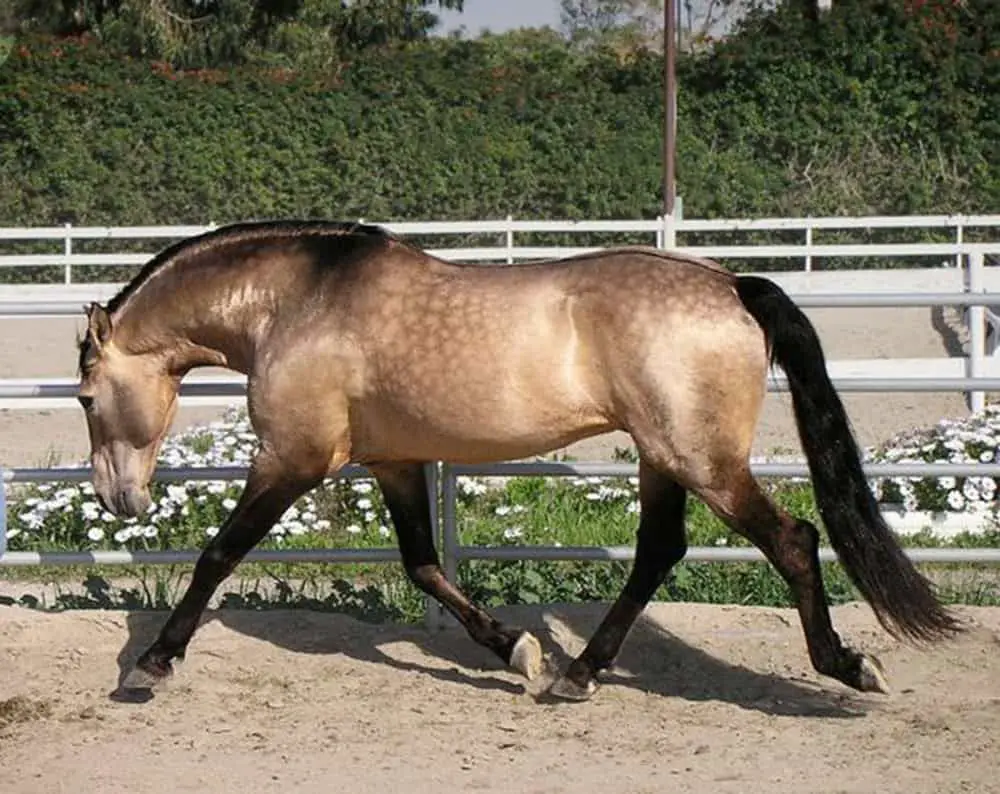
To maintain the health and beauty of a buckskin horse, owners must commit to a care regimen that covers nutrition, grooming, and overall maintenance. Proper care ensures that these horses not only look their best but also live a vibrant and robust life.
Nutritional Management for Buckskin Horses
Feeding a buckskin horse should be a deliberate process that includes:
- Choosing appropriate forage as the cornerstone of the horse’s diet.
- Energy-rich feeds adjusted for the individual horse’s workload.
- Ensuring a full spectrum of nutrients is available in the diet.
Owners should work with equine nutrition specialists to develop a diet that caters to the horse’s specific needs, emphasizing components that contribute to a healthy coat.
Strategic Grooming for a Radiant Coat
A systematic grooming routine is essential for the upkeep of the buckskin horse’s coat, comprising:
- Regular brushing to eliminate dirt and stimulate skin health.
- Use of appropriate equine shampoos that protect the coat’s oils.
- Mane and tail maintenance to prevent damage and encourage fullness.
Regular grooming also serves as an opportunity to monitor the horse’s health, checking for any abnormalities or potential skin issues.
Proactive Hoof Maintenance
Keeping a buckskin horse’s hooves in top condition is crucial and includes:
- Consistent cleaning to safeguard against infections.
- Periodic care from a professional farrier to ensure proper hoof health.
- Moisture management through the use of hoof conditioners when appropriate.
Preventative measures in hoof care are essential to avert complications that can affect mobility and overall well-being.
Adapting to Environmental and Seasonal Variations
Accounting for the environment’s impact on a buckskin horse is important for their care. Appropriate shelter and adjustments in care during extreme weather conditions are necessary to maintain the horse’s coat quality and health. Protective measures against the elements, such as blanketing or sun protection, help in keeping the horse comfortable throughout the year.
Customized Exercise Programs
Physical activity is vital for a buckskin horse’s fitness and well-being. An exercise regimen should be designed to suit the horse’s age and physical capabilities, incorporating a mix of:
- Cardiovascular workouts through riding or driving.
- Ground exercises for behavioral training and flexibility.
- Free movement in a secure area for the horse’s social and physical health.
Regular activity not only strengthens the horse but also contributes to the coat’s luster, showcasing the buckskin’s natural beauty.
By administering comprehensive care that includes balanced nutrition, thorough grooming, hoof care, environmental considerations, and exercise, owners can ensure their buckskin horses thrive. Such diligent attention to care can significantly enhance the horses’ appearance and quality of life, allowing their innate splendor and good nature to shine through.
Enhancing Buckskin Horse Performance through Customized Training
Training buckskin horses calls for a specialized approach that leverages their innate qualities, such as their renowned even-tempered nature and quick learning ability. Effective training strategies cater to their individual needs and emphasize the importance of a positive and patient approach to foster a strong and productive horse-rider relationship. This section will delve into the nuances of formulating personalized training plans for buckskin horses that align with their physical and mental attributes.
Employing Reward-Based Techniques
Utilizing reward-based techniques is crucial in recognizing and promoting the buckskin horse’s natural talents. This includes:
- Offering positive reinforcement for correct behavior to encourage repetition.
- Creating an environment that motivates learning and exploration.
- Redirecting undesired actions with positive alternatives rather than punitive measures.
When these methods are applied with an understanding of equine behavior, they contribute to a comprehensive training program that resonates with the buckskin’s disposition.
Designing Personalized Training Plans
Developing a training regimen that considers the individual buckskin horse’s background, abilities, and objectives is essential. Factors to take into account are:
- The horse’s maturity and stage of development.
- Any prior training and the current competencies of the horse.
- The specific aspirations for the horse, whether for casual riding or competitive purposes.
Adjusting the training to suit each horse’s profile ensures a more engaging and productive learning process.
Cultivating a Trust-Based Partnership
Establishing a deep-seated trust is a fundamental aspect of successful training. Techniques to enhance this bond include:
- Regular interaction to build a sense of security and understanding.
- Being attuned to the horse’s communication signals and responding appropriately.
- Creating a consistent routine that outlines clear conduct expectations.
Trust forms the foundation for effective communication and cooperation, which is essential for successful training outcomes.
Tackling Behavioral Issues with Empathy
Behavioral issues may occasionally arise in buckskin horses, and it is important to address these concerns with empathy. Effective strategies involve:
- Determining the underlying cause of the issue, whether it’s physical discomfort, miscommunication, or fear.
- Applying measured, consistent guidance to steer the horse towards better behavior while minimizing stress.
- Consulting a professional trainer for persistent or complex issues.
A considerate and resolute approach can assist buckskins in overcoming training challenges and excelling in their education.
Blending Groundwork with Mounted Training
Groundwork is pivotal in laying the groundwork for a buckskin’s training, acting as a prelude to riding. Fundamental groundwork exercises include:
- Instilling core commands such as “walk,” “stop,” and “turn.”
- Acclimating the horse to gear in a reassuring manner.
- Practicing lunging to enhance balance and obedience.
With a robust groundwork framework, buckskins can seamlessly transition to ridden work, responding adeptly to the rider’s directives.
Progressing Training Incrementally
Introducing new concepts gradually helps prevent buckskin horses from feeling overtaxed. This approach includes:
- Commencing with straightforward tasks and slowly integrating more complex challenges.
- Injecting diversity into sessions to maintain engagement and curiosity.
- Granting sufficient time for the horse to assimilate each new skill before progressing.
Such a steady approach acknowledges the horse’s learning pace and cultivates a sense of achievement and confidence in their capabilities.
Implementing these strategic training tactics enables buckskin horses to unlock their full potential. Each training phase is an opportunity to reinforce the partnership and mutual respect between horse and trainer, fostering a well-trained equine ready to succeed in a range of equestrian disciplines. With a blend of patience, insight, and adept training, guiding buckskin horses through their education becomes a fulfilling journey for both the equine and the trainer.
Buckskin Horses as Cultural Icons and Symbols
Beyond equestrian circles, buckskin horses have trotted into the realm of popular culture, symbolizing the untamed essence of the American wilderness and the narratives that shape American history. These equines, noted for their unique golden color, have left hoofprints in various artistic and cultural expressions, captivating admirers with their majestic stance.
Influence in Literature
The captivating nature of buckskin horses has inspired writers, leading to their frequent inclusion in novels and stories. In literary contexts, they often stand alongside main characters as steadfast allies, personifying attributes like fidelity and valor. Their notable presence adds an extra layer of richness and credibility to literary works.
Presence in Film and Television
These photogenic horses have also found roles in the film industry, where their agility and intelligence are highlighted. They are chosen for their ability to lend a genuine feel to movies set in historical periods, particularly westerns. Television shows across various genres also feature buckskins, allowing them to retain their appeal in different narratives and settings.
- In Westerns: They are frequently depicted as the trusted steeds of heroic figures.
- In Action Series: Buckskins are selected for dynamic and thrilling scenes.
- In Modern Settings: Their inclusion adds nobility and strength even outside historical contexts.
Use in Marketing and Public Relations
The image of buckskin horses is utilized in marketing strategies to evoke sensations of liberty and exploration. Their depictions in advertising efforts help forge a connection with those drawn to themes of wildness and the outdoors, enhancing branding initiatives for a variety of products.
Roles in Live Events and Competitions
Buckskin horses also attract attention at live equestrian events, such as rodeos and parades, where their elegance and athletic prowess are on display. Their presence at these gatherings not only highlights their skills but also provides a platform to inform audiences about the horse’s storied background and the variety present in the equine world.
Symbolic Significance
These horses have come to embody the spirit of the pioneering days, reflecting the adventures and vast potential of the new frontiers. They occupy a cherished place in the collective memory, signifying the romance and trials of earlier times while continuing to influence modern culture and values.
Inspiration in Art and Consumer Goods
Creatives and artisans often select the buckskin motif for artistic creations, including visual arts, sculpture, and practical crafts like leatherworking and textile design. The buckskin image is a prevalent feature in western-inspired works and products, solidifying its role as an emblematic figure within that cultural motif.
With a striking impact on popular culture, buckskin horses remain a source of inspiration and admiration across various domains, from literary pages to epic films. Their representation in the arts and commerce underscores the persistent allure and respect commanded by the buckskin horse in society.
If you’re keen to expand your knowledge about different types of horses and horse-related equipment, you’ve come to the right place. In addition to exploring the unique characteristics of a buckskin horse, you might also be curious about different horse breeds and vehicles used for their transport. Learn about the sturdy POA horse by reading our article on what is a POA horse, or dive into the history and qualities of a bronco with our piece on what is a bronco horse. And for those interested in how horses are transported, our informative article on what is a horse lorry will provide you with all the details you need. Whether you’re an equestrian enthusiast or just love learning about these magnificent creatures, our articles offer something for everyone.
Conclusion
Appreciating the Versatility and Beauty of Buckskin Horses
In conclusion, the versatility and beauty of buckskin horses are undeniable. From their rich history to their varied types and roles in popular culture, buckskins have proven to be much more than just a color. They are a testament to the enduring bond between horses and humans, emblematic of heritage, resilience, and grace.



